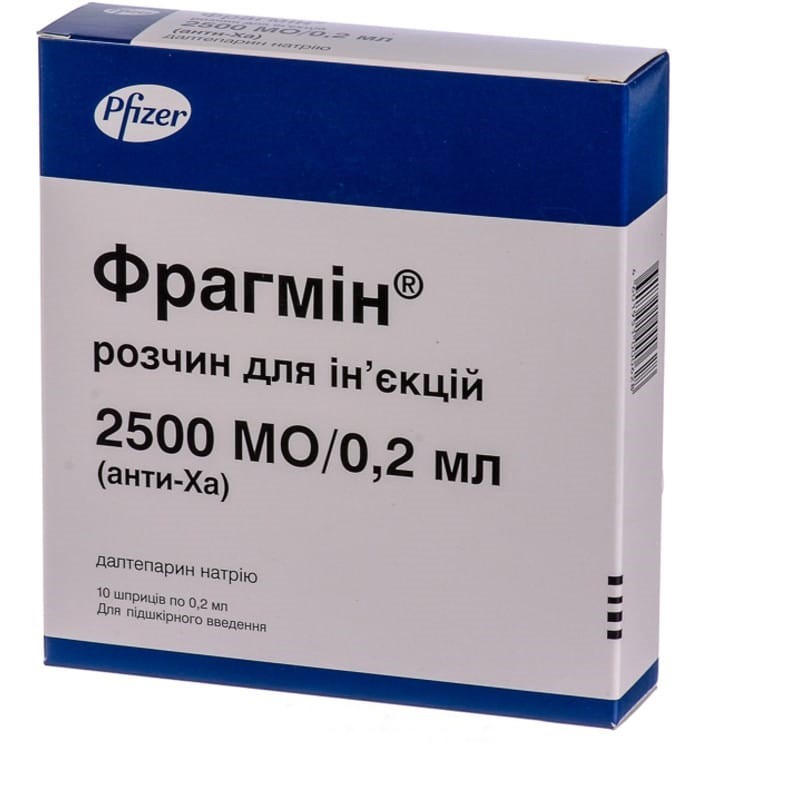



 Secure and encrypted payment processing
Secure and encrypted payment processing We ship to over 40 countries including the USA, UK, Europe, Australia and Japan
We ship to over 40 countries including the USA, UK, Europe, Australia and Japan Guaranteed refund or reship if you haven't received your order
Guaranteed refund or reship if you haven't received your orderDalteparin sodium is a low molecular weight fraction of heparin (average molecular weight 4000–6000 da) obtained from sodium heparin isolated from pig mucous membranes.
Mechanism of action
Dalteparin sodium is an antithrombotic drug whose mechanism of action consists mainly in the ability to enhance the inhibition of Xa factor and thrombin due to antithrombin binding. It has a relatively higher ability to enhance the inhibition of the X-factor than to extend the coagulation time of blood plasma.
Pharmacodynamic action
Compared to the standard unfractionated heparin, dalteparin sodium has a negligible effect on platelet function and adhesion, and thus minimally affects primary hemostasis. It is believed that some of the antithrombotic properties of dalteparin sodium are mediated by its effect on vascular walls or the fibrinolytic system.
Clinical efficacy and safety (when used in doses of 2500 IU / 0.2 ml and 5000 IU / 0.2 ml)
In a randomized, controlled, active drug double-blind study involving 1,500 patients undergoing hip replacement surgery (Fragmin North American study), the use of Fragmin both before and after surgery was more effective than warfarin (Table 1) . Efficacy when using Fragmin before surgery had an advantage over that of Fragmin when used after surgery. Thus, patients in whom the use of the drug Fragmin before surgery is impossible due to the too high risk of bleeding should resort to other means to reduce the risk of thromboembolism, for example, the use of the drug Fragmin after surgery.
Table 1
The incidence of confirmed thromboembolism in the ITT population within 6 ± 2 days after surgery
| Phase 1 | Dalteparin before surgery | Dalteparin after surgery | Warfarin | |||
| n / n | % | n / n | % | n / n | % | |
| DVT and / or pulmonary embolism | 37/338* | 10,9 | 44/336* | 13,1 | 81/338 | 24,0 |
| Proximal DVT | 3/354 | 0,8 | 3/358 | 0,8 | 11/363 | 3,0 |
* p0.001 compared with warfarin (Cochran – Mantel – Hensel test, bilateral); n / N is the number of patients with the phenomenon / the number of patients suitable for assessing effectiveness; after surgery - the introduction of the drug at least 4 hours after surgery; before surgery - the introduction of the drug no more than 2 hours before surgery; DVT - hereinafter - deep vein thrombosis.
In a randomized, placebo-controlled, double-blind study (PREVENT) involving 3,700 patients with an acute therapeutic disease that predictably requires hospital stay for 4 days and a recent (3 days) limitation of mobility (defined as patients bedridden most period), the incidence of clinically significant thromboembolic events in patients randomized to receive Fragmin was 45% lower than in patients receiving placebo. The incidence rate, defined as the primary endpoint, was 2.77% compared with 4.96% in patients receiving placebo (difference: −2.19, 95% confidence interval (CI) −3.57 ÷ −0, 81; p = 0.0015). Thus, a clinically significant reduction in the risk of venous thromboembolism (VTE) was noted during this study.
In a randomized, open, controlled, multicenter study of CLOT (Randomized Comparison of Low-Molecular Weight Heparin Versus Oral Anticoagulant Therapy For Long Term Anticoagulation in Cancer Patients With Venous Tromboembolism), dalteparin was compared with standard oral anticoagulant with long-term use for VTE oncology in 676 patients disease and acute symptomatic VTE (DVT and / or pulmonary embolism) in the anamnesis.
Patients were randomized into two groups:
- the group receiving dalteparin at a dose of 200 IU / kg / day as a sc injection (maximum 18,000 IU / day) for 1 month and at a dose of about 150 IU / kg / day from the 2nd to the 6th month;
- group receiving a vitamin K antagonist for 6 months (target indicator of an international normalized ratio of 2–3) with preliminary s / d administration of dalteparin at a dose of 200 IU / kg / day 1 time per day (maximum 18,000 IU / day) for 5 -7 days.
The most common diagnoses were tumors of the gastrointestinal tract and pancreas (23.7%), the genitourinary system (prostate, testis, cervix, uterus, ovary and bladder) (21.5%), breast (16, 0%), lung (13.3%). 10.4% of patients had hematologic malignant tumors; 75.1% of patients had a metastatic form of cancer.
The incidence of VTE was as follows: DVT developed in about 70%, and pulmonary embolism with or without DVT in 30% of patients.
The time to the first relapse of symptomatic VTE (DVT and / or pulmonary embolism) for 6 months was used as the primary endpoint.
A total of 27 of 338 patients (8%) from the dalteparin group and 53 of 338 (15.7%) patients from the vitamin K antagonist group had at least one phenomenon that was part of the composite endpoint. After 6 months of dalteparin administration, a significant (52%) reduction in the risk of VTE recurrence was noted (relative risk = 0.48; 95% CI 0.30-0.77; p = 0.0016).
Along the edge